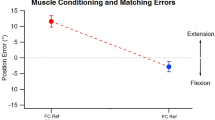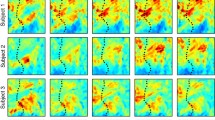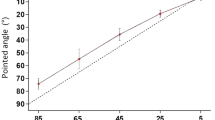Abstract
The present study investigates the coding of positions reached in a two-dimensional space by populations of muscle spindle afferents. The unitary activity of 35 primary muscle spindle afferents originating from the tibialis anterior, extensor digitorum longus, extensor hallucis longus, and peroneus lateralis muscles were recorded from the common peroneal nerve by the microneurographic technique. The steady mean frequency of discharge was analyzed during 16 passively maintained positions of the tip of the foot. These positions were equally distant from and circularly arranged around the "neutral" position of the ankle. The results showed that a same position of the foot was differently coded depending on whether it was maintained for several seconds or whether it was attained after a movement. Muscle spindle activity was increased or decreased, respectively, when the previous movement lengthened or shortened the parent muscle; the magnitude of change in activity depended on the amount of lengthening or shortening in relation to movement direction. Each muscle surrounding the ankle joint was shown to encode the different spatial positions following a directional tuning curve. Data were analyzed by using the "neuronal population vector model". This model consists of calculating population vectors representing the mean contribution of each muscle population of afferents to the coding of a particular position, and by finally calculating a sum vector. The direction of the sum vector was shown to accurately describe the direction of a given maintained position compared to the initial position. We conclude that muscle spindle position coding is based on afferent information coming from the whole set of muscles crossing a given joint. A given spatial position is associated with a stable muscle afferent inflow where each muscle makes an oriented and weighted contribution to its coding.




Similar content being viewed by others
References
Batschelet E (1981) Circular statistics in biology. Academic Press, London
Bergenheim M, Roll J-P, Ribot-Ciscar E (1999) Microneurography in humans. In: Windhorst U, Johansson H (eds) Modern techniques in neuroscience research. Springer, Berlin Heidelberg New York, pp 801–819
Bergenheim M, Ribot-Ciscar E, Roll JP (2000) Proprioceptive population coding of two-dimensional limb movements in humans. I. Muscle spindle feedback during spatially oriented movements. Exp Brain Res 134:301–310
Botterman BR, Eldred E (1982) Static stretch sensitivity of Ia and II afferents in the cat's gastrocnemius. Pflugers Arch 395:204–211
Capaday C, Cooke JD (1981) The effects of muscle vibration on the attainment of intended final position during voluntary human arm movements. Exp Brain Res 42:228–230
Capaday C, Cooke JD (1983) Vibration-induced changes in movement-related EMG activity in humans. Exp Brain Res 52:139–146
Clark FJ, Burgess RC, Chapin JW, Lipscomb WT (1985) Role of intramuscular receptors in the awareness of limb position. J Neurophysiol 54:1529–1540
Clark FJ, Burgess RC, Chapin JW (1986) Proprioception with the proximal interphalangeal joint of the index finger. Brain 109:1195–1208
Cordo PJ, Gurfinkel VS, Levik Y (2000) Position sense during imperceptibly slow movements. Exp Brain Res 132:1–9
Cordo PJ, Flores-Vieira C, Verschueren SMP, Inglis JT, Gurfinkel V (2002) Position sensitivity of human muscle spindles: single afferent and population representations. J Neurophysiol 87:1186–1195
Gandevia SC, Lesley AH, McCloskey DI, Potter EK (1983) Proprioceptive sensation at the terminal joint of the middle finger. J Physiol 335:507–517
Gandevia SC, McCloskey DI, Burke D (1992) Kinaesthetic signals and muscle contraction. Trends Neurosci 15:62–65
Georgopoulos AP (1990) Neural coding of the direction of reaching and a comparison with saccadic eye movements. Cold Harb Symp Quant Biol 55:849–859
Georgopoulos AP, Caminiti R, Kalaska JF, Massey JT (1983) Spatial coding of movement: a hypothesis concerning the coding of movement direction by motor cortical populations. Exp Brain Res Suppl 7:327–336
Georgopoulos AP, Caminiti R, Kalaska JF (1984) Static spatial effects in motor cortex and Area 5: quantitative relations in a two-dimensional space. Exp Brain Res 54:446–454
Gilhodes JC, Roll JP, Tardy-Gervet MF (1986) Perceptual and motor effects of agonist-antagonist muscle vibration in man. Exp Brain Res 61:395–402
Granit R, Homma S (1959) The discharge to maintained stretch of spindles in slow and fast muscle of rabbit. Acta Physiol Scand 46:165–173
Herrmann U, Flanders M (1998) Directional tuning of single motor units. J Neurosci 18:8402–8416
Horch KW, Clark FJ, Burgess PR (1975) Awareness of knee joint angle under static conditions. J Neurophysiol 38:1436-1447
Hulliger M, Nordh E, Vallbo ÅB (1982) The absence of position response in muscle spindle afferents units from human finger muscles during accurate position holding. J Physiol 322:167–179
Inglis JT, Frank JS (1990) The effect of agonist/antagonist muscle vibration on human position sense. Exp Brain Res 81:573–580
Inglis JT, Frank JS, Inglis B (1991) The effect of muscle vibration on human position sense during movements controlled by lengthening muscle contraction. Exp Brain Res 84:631–634
Jones KE, Wessberg J, Vallbo ÅB (2001) Directional tuning of human forearm muscle afferents during voluntary wrist movements. J Physiol 536:635–647
Kalaska JF, Hyde ML (1985) Area 4 and area 5: differences between the load direction-dependent discharge variability of cells during active postural fixation. Exp Brain Res 59:197–202
Kalaska JF, Caminiti R, Georgopoulos AP (1983) Cortical mechanisms related to the direction of two-dimensional arm movements: relations in parietal area 5 and comparison with motor cortex. Exp Brain Res 51:247–260
Matthews PBC (1982) Where does Sherrington's "muscular sense" originate? Muscles, joints, corollary discharges? Ann Rev Neurosci 5:189–218
McCloskey DI, Gandevia S, Potter EK, Colebatch JG (1983) Muscle sense and effort: motor commands and judgements about muscle contractions. In: Desmedt JE (ed) Motor control mechanisms in health and disease. Raven press, New York, pp 151–167
Proske U, Morgan DL, Gregory JE (1993) Thixotropy in skeletal muscle and in muscle spindles: a review. Prog Neurobiol 41:705–721
Proske U, Wise AK, Gregory JE (2000) The role of muscle receptors in the detection of movements. Prog Neurobiol 60:85–96
Ribot-Ciscar E, Roll JP (1998) Ago-antagonist muscle spindle inputs contribute together to joint movement coding in man. Brain Res 791:167–176
Ribot-Ciscar E, Bergenheim H, Roll JP (2002) The preferred sensory direction of muscle spindle primary endings influences the velocity coding of two-dimensional limb movements in humans. Exp Brain Res 145:429–436
Roll JP, Vedel JP (1982) Kinaesthetic role of muscle afferents in man, studied by tendon vibration and microneurography. Exp Brain Res 47:177–190
Roll JP, Vedel JP, Ribot E (1989) Alteration of proprioceptive messages induced by tendon vibration in man. A microneurographic study. Exp Brain Res 76:213–222
Roll JP, Bergenheim M, Ribot-Ciscar E (2000) Proprioceptive population coding of two-dimensional limb movements in humans. II. Muscle spindle feedback during "drawing-like" movements. Exp Brain Res 134:311–321
Schwartz AB (1993) Motor cortical activity during drawing movements: population representation during sinusoid tracing. J Neurophysiol 70:28–36
Scott SH, Loeb GE (1994) The computation of position sense from spindles in mono- and multiarticular muscles. J Neurosci 14:7529–7540
Taylor JL, McCloskey DI (1990) Ability to detect angular displacements of the fingers made at an imperceptibly slow speed. Brain 113:157–166
Taylor JL, McCloskey DI (1992) Detection of slow movements imposed at the elbow during active flexion in man. J Physiol 457:503–513
Vallbo ÅB (1974) Afferent discharge from human muscle spindles in non-contracting muscles. Steady state impulse frequency as a function of joint angle. Acta Physiol Scand 90:303–318
Vallbo ÅB, Hagbarth KE (1968) Activity from skin mechanoreceptors recorded percutaneously in awake human subjects. Exp Neurol 21:270–289
Vallbo ÅB, Hullinger M, Nordh E (1981) Do spindle afferents monitor joint position in man? A study with active position holding. Brain Res 204:209–213
Verschueren SMP, Cordo PJ, Swinnen SP (1998) Representation of wrist joint kinematics by the ensemble of muscle spindles from synergistic muscles. J Neurophysiol 79:2265–2276
Wise AK, Gregory JE, Proske U (1998) Detection of movements of the human forearm during and after co-contractions of muscles acting at the elbow joint. J Physiol 508:325–330
Acknowledgements
This work was supported by grants from CNRS, INSERM, "Marseille Provence Métropole", the Swedish Council for Work Life Research, and the Swedish Foundation for International Cooperation in Research and Higher Education.
Author information
Authors and Affiliations
Corresponding author
Rights and permissions
About this article
Cite this article
Ribot-Ciscar, E., Bergenheim, M., Albert, F. et al. Proprioceptive population coding of limb position in humans. Exp Brain Res 149, 512–519 (2003). https://doi.org/10.1007/s00221-003-1384-x
Received:
Accepted:
Published:
Issue Date:
DOI: https://doi.org/10.1007/s00221-003-1384-x




